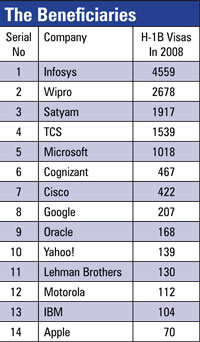There is much difference between charity and social responsibility. If one were to gloss over the Indian history, almost all prominent thinkers have emphasised social responsibility, referring to it as ‘Dharma’. So there was the Raja’s dharma towards his population, the population’s (jan) dharma towards the land and so on. Sadly, the concept of Dharma seems to have fallen out of favor for Indian corporates, like any other capitalist entity their sole focus seems to be in amassing wealth. The little that they do, they do it as a favor.
Take the case of Indian IT, not many companies have a CSR policy so as to state, and even those that do, have it just in writing. Most of the companies are having small itsy-bitsy projects on education, etc. There is the famous case of a multinational that adopted a village and made a lot of hue and cry about it, and next year it even took away the computers that it had installed.
The good thing is that it is the MNC’s itself, who have brought the concept of CSR in India. And Indian companies need to learn from them. The notable exception will always be the TATAs. Today, every Indian citizen takes the name of the company with immense respect, only because of the amazing work done by the company. And to think of it, they were doing it for over a century, when the concept of CSR wasn’t even born. So, to be honest, Tatas have been the only ones who have lived by the Dharma, the rest are more or less Adharmis (sounds a wee bit too harsh).
Anway, I had done an extensive article for the Dataquest, where I had examined CSR policies of various companies, namely IT and how they are faring. Here is the story….
——————————————————————————
The charitable side of Indian IT
There is one kind of charity common enough among us… It is that patchwork philanthropy which clothes the ragged, feeds the poor, and heals the sick. I am far from decrying the noble spirit, which seeks to help a poor or suffering fellow being… [However] what advances a nation or a community is not so much to prop up its weakest and most helpless members, but to lift up the best and the most gifted, so as to make them of the greatest service to the country.
— Jamsetji Tata
Tata is more than a surname in India. Tatas are one of the largest industrial conglomerates in India, yet the fame of the group is not indebted to company’s economic prowess. The name symbolizes trust and ethicality, an intangible asset that has accumulated over a long period of time. Parents are known to have beatific smile when their wards join any Tata company. Not many years in the past, employees would put up with lower salaries, just because it happened to be a Tata company. The answers are not really that hard to find.
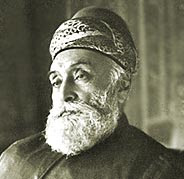
In the late nineteenth century, when Jamsetji Nusserwanji Tata founded the group; corporate ethics or social responsibility were coins that were yet to be minted. Still, Tata took a wholly different approach. He talked about human resource management, giving back to the community and philanthropic initiatives. His successors followed suit and over time Tata Group transformed from being just another a corporate entity to a trusted brand name.
Sadly for India, there have not been many such stories. A few individuals did shine through their philanthropy efforts, but such cases have been few and far between. The whole idea of companies returning to their community was something that was fairly unheard of. Making ad hoc donations to a few NGOs or arranging a blood donation drive was the maximum that a company indulged in.
Trends elsewhere
Globally, for the past many years, companies have embraced concepts like corporate social responsibility (CSR) or corporate philanthropy. CSR basically boils down to how a company evaluates the macro impact of conducting business in a locality, and conducts business in a manner that it meets all the regulatory and mandatory requirements as well as non-regulated spheres, internal and external, that could be affected by specific actions or business policies. Simplistically, best business practices with a touch of social welfare.
Most of the CSR activities in foreign countries are driven by regulatory needs and requirements. Thanks to stiff trade policies, most of the companies have to ensure that the workforce is not exploited, the environment is not polluted, etc. For instance, most of the international treaties are pretty stern on the issue of child labor and hence, companies have to make sure that they do not use young children as workforce. Beyond that many companies are coming to realize that CSR could have immense business value as well.
By developing the ecosystem, a company can ensure its future profitability and viability. Thus, companies like Wal-Mart, McDonalds, Microsoft are not only doing things for the community at large they are increasingly also talking about it.
CSR Vs corporate philanthropy
CSR is often confused with corporate philanthropy. But there is a big difference between the two; donating for causes and charities falls under the ambit of philanthropy but CSR is an assimilation of all these and more. Thus a company in spite of making heavy donations for various charitable causes might be rated rather lowly on the CSR index simply because it does not treat it employees well.
Philanthropy is more individualistic in nature and is often driven by individuals, namely company head honchos. Whereas CSR is much more broader than charity or philanthropy, it is a socially conscious business strategy geared towards economic gains and larger welfare. Yet this subtle difference, not many are able to discern.
In his bestseller, “The Living Company,” author Arie de Geus compares an organization to an individual. He talks about how individuals are often conscious about the environment they exist in; similarly corporate entities need pay attention to the overall economic condition of the locality they function in. De Geus compares two organizations, namely one that is centered on maximizing gains and the other that is conscious about social upliftment. The first one is like a puddle of rainwater in a cavity, while the second is a continuous river that keeps flowing. With time, the company that was solely concerned about profitability withers away, while the second one continues to change with times and lives on for much longer span.
Desi awakening
To be fair, off late Indian companies are waking about concepts like CSR and increasingly are talking about such initiatives. Some of the companies are even talking about the next-step, integrating it in their corporate strategy map. The good news is the new sector, namely the IT industry is showing the path to corporate India. More and more tech companies are taking active interest in CSR related projects and encouraging their employees to take part in them as well. “Being a part of the society, it’s not just the individuals who can make a difference to the people, to the environment or to various other institutions around them. Giving back a part of the benefits that the company got over a period of time from the society and building an eco-system with strong values is a responsibility and not a service,” says Pradip K Dutta, managing director and president, Synopsys.
Dittos Neelam Dhawan, managing director, Microsoft India Private Limited. “Today CSR is emerging to be a core focus area for an increasing number of organizations who are looking at new and innovative ways to contribute to the communities they operate in, going beyond just helping the immediate customers and shareholders. For us at Microsoft this sense of broader responsibility for communities we operate in is reflected in all our community engagement programs today and underlines our mission of building a digitally inclusive society in India,” she says.
Role of the multinationals
Barring a top few domestic IT companies, it is the MNCs that are doing a bulk of work in the CSR domain. Like it takes a Steve Waugh to show to Indian cricketers how charity can be done. Similarly, the MNCs are leading the pack in terms of CSR projects. With the Bill & Melinda Gates Foundation, Microsoft is working with the underprivileged segments of society on issues like education and healthcare. Microsoft in India has also initiated a dedicated project for CSR, Jyoti.
“Project Jyoti is the dedicated CSR program that marks a continuation in this journey. Project Jyoti aligns with Microsoft’s global program – Unlimited Potential wherein we are making a long-term investment of more than $1 billion in cash and software over the next five years to aid technical skills training and lifelong learning for communities around the world,” says Dhawan. Microsoft in India till date has worked with over 10 NGOS and has made software and cash grants amounting to a total of Rs. 30 crores, she mentions.
Intel is another company that has been fairly active in India. “Under the umbrella of the Outreach program, Intel in India has been working to increase literacy, specifically in science, mathematics and computer literacy. We have invested substantial efforts and money in CSR projects in India. Our main focus has been in the K-12 (children up to 12 years). We have different projects running, like Intel Teach, wherein we have a fairly comprehensive training program for teachers to learn computers. We have trained around 6,00,000 teachers in 14 states in India,” says Timothy McGuill, Asia Pacific Region PA (India Public Affairs), Intel.
IBM too has initiated a host of CSR projects in India mainly targeted at increasing computer literacy among the children. “IBM’s philosophy is not just to get involved in community but also to stay involved in order to bridge the digital divide that exists in the society. Hence, most of our corporate community relation initiatives are ongoing campaigns, designed to impart education to lesser-privileged children across age groups through technology. IBM’s Community initiatives – internationally and in India – focus on education and children,” says Jalaja Pillai, manager (Corporate Community Relations), IBM India.
The database major Oracle is also active in its own ways in India. The company has tied up with a number of schools and universities for different CSR projects. “I am very happy and hopeful about our participation in these projects. As these projects have the potential to have a much wider impact on the society and that is what matters really in the end,” said Krishan Dhawan, managing director, Oracle (India).
The Triumvirate
The big three of Indian IT are carrying the flag for domestic players in India. Of these Infosys and Wipro, have carved special entities to take care of CSR activities. Infosys Foundation and Azim Premji Foundation are the two entities working in this space. Both of them are working in more or less similar domain, namely healthcare, social rehabilitation and rural upliftment, learning and education, art and culture. While Infosys could not talk about its CSR projects due to legal and regulatory issues (as it is filing an ADS), Wipro was unreachable even after numerous attempts.
Very strangely though, the biggest IT company in India does not seem to be too hot in the CSR space. It could be that it depends on the Tata Group’s philanthropic arm to conduct CSR activities. It has a few projects to its credit and its CBFL (computer based functional literacy) project has been quite well received. The project was the brainchild of former TCS chairman F.C. Kohli, also known as the father of Indian IT. In a conversation earlier, he has mentioned that CBFL as a pilot was a resounding success, now it was upon the state governments to take it to fruition.
Somehow, TCS does not seem to do justice to its lineage. A lot more is expected from a company that has a Tata in its name. While Infosys has a mandate that it would contribute up to 1% PAT (profit after tax) every year, TCS does not seem to have a fixed mandate.
It would be criminal not to talk about Satyam, the company with its philanthropic arm Byrraju Foundation is doing a host of healthcare and education projects specifically in the under privileged areas of Andhra Pradesh and other states.
CSR Drivers
According to NASSCOM Foundation’s Catalysing Change (2005-06) report; founder’s vision continues to remain the primary driver for CSR in Indian IT industry. While company’s reputation came third (15%), business challenges came in fourth (13%). Other issues were termed as the premier driver for CSR by companies.
It is fairly obvious that the CSR in India is still linked to individuals, so Narayana K Murthy is a driving force behind Infosys Foundation, while Azim Premji is the inspiring light behind Wipro’s philanthropic arm. Corporates have to yet to truly awaken to the underlying economic benefits that can accrue from CSR.
Issues that matter
The child is the father of man, said Shakespeare. And it would seem that IT companies in India are quite concerned about this would-be father. Unarguably, child relief projects are the most popular avenue for companies to work on. From Intel to Satyam, every company worth its salt is working in this space, promoting child literacy or exposing them to the magic of computers.
The other major interest area for companies is disaster relief. Whenever there is a natural calamity, like Tsunami most of these corporates donate heavily towards such causes. For instance, Intel had adopted a whole village stuck by Boxing Day Tsunami.
Employee Support
It goes without saying that most of the programs conducted by these corporates are completely dependent on employee participation. Many of the companies encourage their employees to take up volunteer work. “Xansa CSR is almost entirely volunteer driven with Xansa staff being the key implementers of the various CSR initiatives. More than 400 staff is actively involved in these programs,” mentions Louis Hall, chief operating officer, Xansa India.
By involving employees, companies achieve two things; it results in better employee morale as it gives the worker a sense of belonging towards the company. Secondly these employees turn into brand ambassadors for the company and spread the word around. A beaming employee is worth more than a full-page advert.
There are also some unique and interesting projects taken up by companies. For instance Sapient India’s MD Soumya Banerjee had auctioned to slave a day to any employee. Eventually, the silent auction went for Rs. 35,000 that was donated to charitable causes.
Branding exercise?
This brings us to the essential question, is CSR just another branding exercise, a way to create a favorable impression among the stakeholders and public at large? That was a view that was prevalent a few years back, but gradually that is changing as well. Many corporates now understand the need for CSR and are pretty serious about it as well. While HR dept is often entrusted with the task to carry out CSR projects. A few companies have gone ahead and established a small team to look into such activities.
One such company is CSC. There is a social services committee at CSC that takes care of all such projects. “The social services committee (SSC) at CSC analyses projects on multiple parameters including on the parameter of their financial viability. The senior management mentor of the SSC may be contacted for direction. Most decisions on CSR are taken in the beginning of the SSC term at CSC, which lasts six months each, but may be taken in the middle of the term as well,” says Bidyut Kanti Thakur, Asst. VP, CSC India Pvt. Ltd/ Mentor SSC(Social Services committee) CSC.
George Paul, executive vice president, HCL Infosystems Ltd. feels that CSR goes beyond branding and advertising and most of the companies are realizing this. “Corporate Social Responsibility to HCL Infosystems is all about contributing and returning back to the society. Increasingly, people with a stake in the company, example clients, suppliers, employees, partners the community, (and more), expect a company to be doing this. We strive to improve and return back to the society, of which we are part of,” he says.
Interestingly, Pillai from IBM summarizes the issue beautifully and makes a business case for CSR. “Corporate Social Responsibility makes sound business sense. Indian companies and MNCs in India are increasingly sending out this message. A growing number of companies and institutions in India are seeking to link their own growth and survival to the social cause they try to promote,” he says, adding, “there is a much larger reason for companies investing in CSR, grounded in the reality that business cannot succeed in a society which fails. It has, therefore, become imperative for companies to understand the social milieu in which they function. Public acceptance of the operations of any business, particularly in an alien society, often determines the success or otherwise of corporations. Such acceptance comes from the company in question being seen in empathy with the aspirations and values of the society in which it functions.”
In the end
In a country like India, there is never an end to what can be achieved. It is true for business and is true for social work as well. The good thing is that companies are increasingly becoming aware of their responsibilities to the society at large. And it is not the big fishes that are taking a lead; even the small ones are standing up and doing their bit. As Rufina Fernandes, CEO, NASSCOM Foundation says, “one does not need to be a big company to make a difference. It is a myth that there is a direct correlation between money spent and the impact it has on the community. A lot many so-called small companies do a whole world of good even with their limited capacities.” Companies like Joppassna and Acceltree are a good example of this. Based in Pune these two companies are doing their bit for the community.
Yet some challenges persist, as Mcguill from Intel says, “currently the CSR activities are happening in lot isolation. These dots need to be connected in someway.” For instance, he talks of an occurrence, where Intel and a competition were funding a computer literacy program in the same school itself. “There is a lot of overlap that could be avoided and needs to be avoided,” he says.
The government also needs to be more aware of CSR and needs to implement policies and strategies that promote it. Not just from the regulatory point-of-view but general welfare, there could be incentives like tax benefits for companies that are rated highly on CSR quotient. Companies could also look at reporting their CSR spend in the annual reports according to international benchmarks like, ILO Conventions, UN Millennium Development Goals, etc.
All in all, the seeds have been sown and the saplings are taking root. The results will only be visible a few years down the line. Coming back to Jamshetji, when he started off Tata, he could have barely guessed that his enterprise would be so profitable and so respected even a century later. But as highlighted earlier, it is not how much money you make, but how you make that money and how you spend it; is all the makes a difference.
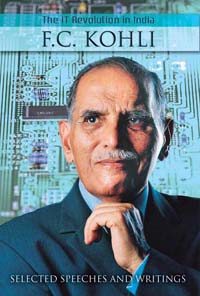 states that these labels do not affect him, though he adds, “I have received lot of respect from people. What more could I have asked for?”
states that these labels do not affect him, though he adds, “I have received lot of respect from people. What more could I have asked for?”
 considered to be a support one. Today, the IT department is critical glue that not only connects the disparate functions within the company but now is also a strategic one than can help in curtailing costs and gaining market share. As the weight age of the IT function zoomed over the years, so has the stock value of the CIO.
considered to be a support one. Today, the IT department is critical glue that not only connects the disparate functions within the company but now is also a strategic one than can help in curtailing costs and gaining market share. As the weight age of the IT function zoomed over the years, so has the stock value of the CIO. 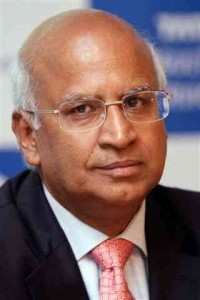

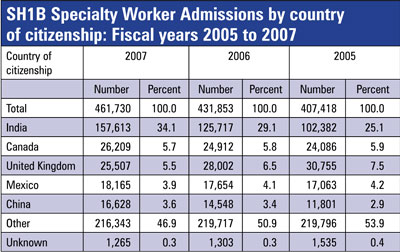 business line. He talked about pumping money in the economy and more importantly ensuring that Americans did not lose their jobs to migrant workers (read Indians). In fact, he had even spoken against the H-1B Visa program, wherein companies were allowed to bring in specialist workers for some 6 odd years in the US.
business line. He talked about pumping money in the economy and more importantly ensuring that Americans did not lose their jobs to migrant workers (read Indians). In fact, he had even spoken against the H-1B Visa program, wherein companies were allowed to bring in specialist workers for some 6 odd years in the US.